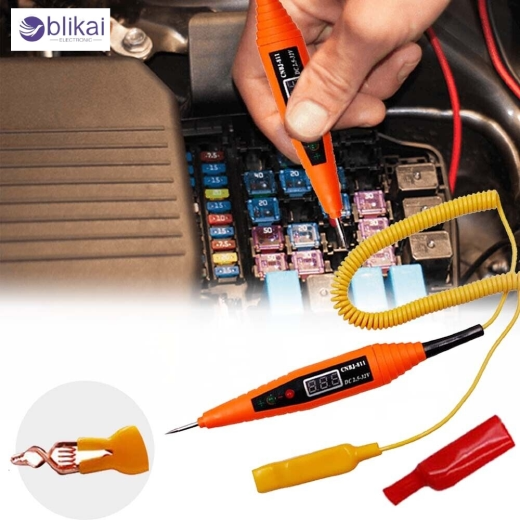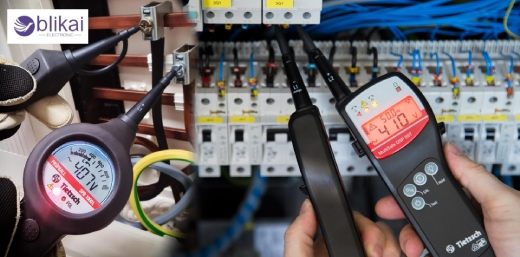How to Choose the Right Circuit Tester
Understanding Circuit Testers
Electricians, technicians, and, of course, DIY enthusiasts use circuit testers as diagnostic tools to determine if electrical current exists in circuits, wires, or components. These devices are made to detect voltage, continuity, and polarity, helping users realize possible problems and, therefore, safeguard working conditions. The main aim of a circuit tester is to extract the risks out of electrical systems and enable efficient troubleshooting of electrical systems.

Types of Circuit Testers
There are several types of circuit testers available, each suited for specific applications:
- Non-contact voltage testers: These handheld devices can detect voltage yet not make actual contact with live wires.
- Multimeter: This is an all-around measuring device with many functions measuring voltage, current, and circuit resistance in many electrical systems.
- Continuity testers: These are used to check if a circuit is complete and, thus, if there are any breaks in the electrical pathway.
- Outlet testers: Outlet testers check for correct wiring in electrical receptacles.
Key Features to Consider
When choosing a circuit tester, it's essential to consider the following key features:
- Voltage range: The voltage ratings required for your work should be determined by the tester's indicated voltage range.
- Accuracy: Select one whose reliability lies in the precise measurement of readings taken.
- Safety ratings: Because they may come as certifications, check to discover if manufacturers are meeting the given safety guidelines for such devices.
- Durability: Select something that can withstand the rigors of your working environment.
- Additional functions: Some testers have extra functions like data logging and connection to cell devices.
Assessing Your Specific Needs
Residential vs. commercial use
When deciding on a multimeter, one must keep in mind whether the intended application will be residential or commercial. Residential testers will work on the low-voltage electrical systems that one usually finds at home; therefore, they are easier to use but, also, smaller and more compact for the homeowner or DIY user. Commercial testers are larger and can be used with higher voltages and for more complex electrical systems and continuous use in the industry.
Frequency of use
How often you will be using this tool really matters. If you are using a circuit tester as an electrician every day, you will need a sturdy and high-quality tester that can withstand daily figureheads. For essential home use, you can get away with a simpler version. However, you also need to consider factors such as build quality, battery life, and how long you expect the tester to last before considerations of constant use.
Voltage range requirements
Various electrical systems operate at different voltage levels during operation. Make sure that the circuit tester you opt for works with the voltage range that you are using. In most cases, the residential voltages operate at 120 and 240 volts. Commercial and industrial systems operate at voltages of 480 volts and sometimes even higher. Pick out a tester whose voltage reasonably accommodates your current needs while leaving a little margin for future scenarios when your requirements may change.
Safety certifications
When working with electrical equipment, safety should always come first. Search for circuit testers that carry certification by a recognized safety organization like UL (Underwriters Laboratories) or CE (Conformité Européenne). Such certifications guarantee that certification standards were met and that the tester has undergone rigorous testing. It can also help to consider testers with safety oversight features like overcurrent protection, automatic shutoff, etc.

Evaluating Circuit Tester Functionality
Voltage detection capabilities
When evaluating circuit tester functionality, voltage detection capabilities are paramount. A quality circuit tester should accurately measure a wide range of voltages, typically from 12V to 600V AC/DC. Look for testers with auto-ranging features, which automatically adjust to the appropriate voltage scale, saving time and reducing the risk of incorrect readings.
Continuity testing
Continuity testing is crucial for identifying breaks or shorts in electrical circuits. A suitable circuit tester should provide clear audible and visual indicators when continuity is detected. Some advanced models offer adjustable continuity thresholds, allowing for more precise testing in various scenarios.
Polarity checking
Polarity checking ensures that electrical connections are wired correctly. A reliable circuit tester should clearly indicate whether a connection is appropriately polarized, typically through LED indicators or display readings. This feature is essential when working with AC outlets or DC circuits.
GFCI testing
Testing the GFCI is vital in ensuring that such safety devices function correctly. Use a circuit tester that can simulate ground fault conditions to confirm that the GFCI outlets trip as they should. Circuit testers provide insight into the trip time for greater detail on GFCI performance.
Arc fault detection
Arc fault detection is a newer feature included in specific advanced circuit testers. This technology helps identify potential arc faults that could present considerable fire hazards. Not all circuit testers offer this capability, but they offer distinct advantages to electricians working in residential and commercial settings where AFCIs are installed.
Considering Ergonomics and Design
Size and portability
Select a circuit tester based on its size and portability. A small, lightweight device is easier to control in tight spaces and will limit fatigue if working for extended periods. Select models that can snugly fit in varying sizes of tool belts and pockets to allow for quick access when needed. Some testers may even feature carry cases or protective holsters for extra portability and protection.
Display readability
Display readability is crucial for usability and efficiency, so consider large LCD displays that are backlit to provide clear, easy-to-read measurements even in dark conditions. Professional testers may have color displays or graphical interfaces to facilitate interpretation. Take note of the angle at which the display can be viewed and the contrast ratio so you can see well from pretty much any position.
Durability and ruggedness
A circuit tester must withstand rough handling and potential impacts in the demanding environment of electrical work. Look for testers with robust construction, such as reinforced casings or rubberized exteriors, to protect against accidental drops. Water and dust resistance ratings (IP ratings) are also important, especially for outdoor or industrial use. Some manufacturers offer testers with shock-absorbing features or impact-resistant screens, further enhancing their longevity and reliability in challenging work conditions.
Essential Safety Features
Auto-shutoff function
A circuit tester must be a priority for the user's safety; among the most important features to look for is the auto-shutoff. This intelligent feature automatically turns off the device after a little while to prevent wasting battery charge and accidental readings.
An auto-shutoff function extends the life of your circuit tester. This function automatically cuts power and shuts down the device after it is removed from active duty. The nature of this automatic feature is significant for professionals: they may work long hours or in arduous conditions, and it may be impossible to track the status of your tester.
Overload protection
This overload protection is one critical safety feature in-circuit testers that protects both the user and the circuit tester itself from a sudden surge in voltage or current. Whether sudden surges or spikes lead to electric accidents or tool life failure, the overload protection system cuts the circuit when the voltage/current exceeds the circuit tester's permissible working limits.
Low battery indicator
A low battery indicator may not seem like a big deal, but it can enhance your working efficiency and maintain safe practice. A low battery warning system will tell you that your battery supply is approaching its end and that you need to prioritize replacing it.
Conclusion
Choosing a good circuit tester is very important in ensuring that a task is done safely and accurately. Understanding all the types of circuit testers available, assessing your particular needs, evaluating files, considering ergonomics, and finally identifying all useful safety features will go a long way toward making the right choice that conforms to your expectations.
Remember, a good quality circuit tester eases your work while providing some protection against unsafe working conditions. Therefore, take time to research and compare different models, and do not hesitate to include recommendations from the experts around you and experienced colleagues. With the correct circuit tester at hand, you will be sufficiently well-equipped to deal with a variety of jobs, from minor electrical tests to more complicated ones, confidently.
Related Articles
Types of Circuit Breakers: Overview and Applications
Discrete Circuit vs Integrated Circuits: What's the Differences?
Best FHP100N07 Replacement MOSFETs for High-Performance Circuits
Microprocessor vs Integrated Circuit:Which One Is Better
What is an Integrated Circuit (IC)? Working, and Types (Guide)
Integrated circuit chip: Types, Applications, and FAQ
Microprocessor Vs Integrated Circuit: What’s the Differences?
Varistors: How Do They Safeguard Circuits?
Simple Electronic Circuits for Beginners
Phototransistor : Circuit Pinout & Principle
Watt Amplifier Circuit:Types,Principle and Applications
LM386 Audio Amplifier Circuit: Features, Applications and Datasheet
What Is Circuit Protection And Why Is It Important? (Guide)
Isolator vs Circuit Breaker: What's the Differences?
Applications of Circuit Protection: Everything Explained










